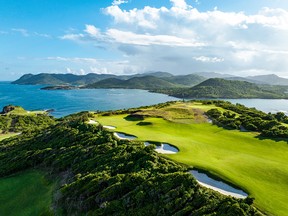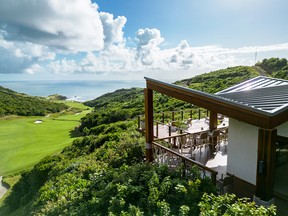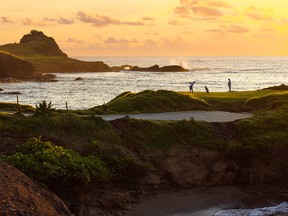Reviews and recommendations are unbiased and products are independently selected. Postmedia may earn an affiliate commission from purchases made through links on this page.



Ben Cowan-Dewar is architect of a growing empire that began with a bang in Cape Breton. The most buzzy development yet: Cabot Saint Lucia
Reviews and recommendations are unbiased and products are independently selected. Postmedia may earn an affiliate commission from purchases made through links on this page.
When kids his age were assembling LEGO sets, 10-year-old Ben Cowan-Dewar was also drawing up blueprints for golf courses. The sketches were meticulous and detailed; they even had locker rooms.
By age 11, he took those ideas and built a proper, working golf course on his family’s farmland.
Article content
Throughout his school years and into early university, Cowan-Dewar’s thoughts never strayed from the game. At 19, he founded Golf Travel Impresarios, which organized and operated private golf trips. It was the early days of the internet, and he was shrewd enough to see the value of combining the two.
Advertisement 2
Article content
“This was back in 1999, when the internet wasn’t the first place where people went to get their travel information. Details were pretty rudimentary at that time. There were no photos. If a resort wanted to send you something, it was usually a paper brochure sent through the mail. I saw the internet as the perfect vehicle to send information — and photos — instantly, to help people plan their golf vacations.”

At 25, he started planning to build a golf course in what was then a highly unlikely spot, rural Cape Breton, on the site of a former coal mine. It was a massive success when it opened in 2012, ranked 10th in the world by Golf Digest’s World’s 100 Greatest Golf Courses. Golf Digest called it the world’s Best New Course.
Before he hit 40, he emerged as the Canadian king of luxury golf.
Cowan-Dewar is co-founder and CEO of the Cabot Collection, and, along with his partner and mentor, Mike Keiser, oversees a group of elite courses around the world and is the developer and operator of a collection of luxe residential, resort golf and master-planned communities.
“I’ve always loved golf, but I’m as much in love with the game as with the courses,” says Cowan-Dewar. Now in his early 40s, he divides his time between Toronto and Cape Breton.
Article content
Advertisement 3
Article content
The company’s portfolio includes award-winning properties throughout the world — from Nova Scotia to British Columbia, Florida to the Caribbean, and even Scotland, the birthplace of golf. Golfers and industry insiders laud their meticulous planning and attention to detail, leveraging not only the landscape, but the sites’ history.
Cabot Cape Breton, where land meets sea at every hole, helped resurrect the faltering economy of Inverness, N.S, and is now a fan favourite: “Without being too dramatic, this was by far the best golfing experience I have had in my life,” wrote golfer Adam Young on practical-golf.com in his review of the course.

Other Cabot properties garner similar reviews.
Cabot Citrus Farms in Brooksville, Fla., for example, opened for preview this year as Cabot’s first U.S. golf destination and is surrounded by thousands of acres of forest.
Cabot Highlands in Inverness, Scotland, electrified the golf community, especially following Cabot’s acquisition of the iconic Castle Stuart and the award-winning golf links that surround the property. The resort lies in the charming town of Inverness, considered the entrance to golf in the Scottish Highlands.
Advertisement 4
Article content
Cabot Revelstoke in B.C., Cabot Collection’s second Canadian location, scheduled to open in 2025, leverages the natural beauty of the Selkirk Mountains in an all-season setting for world-class golf and skiing, including heli-skiing.
Last Christmas, Cowan-Dewar and Keiser opened their most buzzy development yet: Cabot Saint Lucia.
It occupies a 375-acre peninsula at the northern tip of Saint Lucia, a Caribbean version of the original, perched-at-the-end-of-the-world Cape Breton course, designed by noted architects Coore & Crenshaw with breathtaking vistas of the land and waters.

“It’s very possible that Cabot Saint Lucia is the most visually stunning piece of land we have ever worked with,” Bill Coore, principal of Coore & Crenshaw, said in a media statement.
In January, Forbes magazine summed up the play this way: “The initial offering of lots and residences on the property have been scooped up, with $160 million in real estate sold to date. That tally will hit $230 million when the latest phase consisting of 12 four-bedroom villas starting at $5.65 million finds buyers.”
Advertisement 5
Article content
Forbes reported the club’s three-level clubhouse will include two restaurants plus bowling lanes and a movie theatre.
“Cabot’s newest Caribbean course lives up to the hype — and then some,” according to a Golf.com magazine headline in January.
“Eight holes play along the shoreline, and the crystal-clear water of the Caribbean Sea is visible from more than half the course. If you’re someone that likes to put their phone away while playing, you might want to reconsider at Point Hardy. The views make it nearly impossible to keep from snapping a picture or two while you play,” writer Zephyr Melton gushed on Golf.com.
“The signature stretch of the course — Nos. 15-17 — features a short par 4 and back-to-back par 3s, and each is postcard perfect. You’ll play three tee shots over water and putt on greens framed by the ocean beyond. The entire course is beautiful, but this trio of holes will have you pinching yourself.”
In November 2023, Golf magazine announced all four of the company’s regulation-length golf courses had been named in the prestigious Top 100 Courses in the World — a rarity for a golf brand, and one so proudly Canadian.
Advertisement 6
Article content

Every 18-hole Cabot golf course currently open has made this coveted list, including Cabot Cliffs and Cabot Links at Cabot Cape Breton, Point Hardy Golf Club at Cabot Saint Lucia and Castle Stuart Golf Links at Cabot Highlands in Scotland.
According to writer Adam Stanley in PGA.com, Cowan-Dewar is “arguably the brightest mind in golf-course development right now, with his existing projects continuing to be bucket-list spots for weekend warriors and even the best in the world … Brooke Henderson, the 13-time LPGA Tour winner, recently teed up at Cabot Cliffs, calling it ‘so amazing and beautiful.’”
It’s a heady moment for Cabot. But Cowan-Dewar admits there were times where he did everything to just stay a stormy course, weathering financial crises and even the recent pandemic. At one point in 2007, he poured his life savings into Cabot Cape Breton while hustling to purchase parcels of land. “When I initially set out to create this ‘golf world,’ I had on a set of rose-coloured glasses. I was young and very passionate.”
He credits much of his fortitude to his parents; his mother kept every single one of those childhood sketches.
Advertisement 7
Article content

“I think I was lucky enough to have two parents — my mom’s a doctor, still practising, and my dad’s a retired stockbroker — who are also amazing mentors. They encouraged me every step of the way.”
He also credits two other people: Keiser, who he calls one of his life’s greatest gifts beyond his immediate family, and a “brilliant” banker he met as a summer student at Scotiabank.
“She had this tireless work ethic and she was really inspiring, and taught me how a strong work ethic could guide a person to what they wanted in life … her influence has stayed with me to this day.”
In his office is a sign: Work Hard And Be Nice To People.” In person, Cowan-Dewar, a married father of three, is friendly, affable, down-to-earth and enthusiastic — especially about the game at the centre of his growing empire.
Golf, he says, “fulfils so many mandates. It teaches patience, it offers antidotes for mental health. It connects a person with nature.”
Does he play regularly?
“Ah, to be honest, I rarely get to play golf now,” he says. “There’s so much happening, it’s hard to find the time.”
Recommended from Editorial
Article content